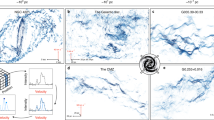Play all audios:

ABSTRACT THE recession-law, _v_ = _r_/_t_ in combination with the density-distribution law _ndxdydz_ = _Btdxdydz_/(_t_2 _r_2/_c_2)2, can be shown to be a valid description of a certain
system of particles in motion on _any_ relativistic law of gravitation. This was the subject of my lecture to the London Mathematical Society, “World-Gravitation by Kinematic Methods”,
delivered on May 17 last (see NATURE, May 26, 1934, p. 789). A full discussion of this subject is given by me in a volume now passing through the press. Access through your institution Buy
or subscribe This is a preview of subscription content, access via your institution ACCESS OPTIONS Access through your institution Subscribe to this journal Receive 51 print issues and
online access $199.00 per year only $3.90 per issue Learn more Buy this article * Purchase on SpringerLink * Instant access to full article PDF Buy now Prices may be subject to local taxes
which are calculated during checkout ADDITIONAL ACCESS OPTIONS: * Log in * Learn about institutional subscriptions * Read our FAQs * Contact customer support SIMILAR CONTENT BEING VIEWED BY
OTHERS UBIQUITOUS VELOCITY FLUCTUATIONS THROUGHOUT THE MOLECULAR INTERSTELLAR MEDIUM Article 06 July 2020 THE RADCLIFFE WAVE IS OSCILLATING Article 20 February 2024 UNIVERSALITY IN THE
RANDOM WALK STRUCTURE FUNCTION OF LUMINOUS QUASI-STELLAR OBJECTS Article 02 February 2023 Authors * E. A. MILNE View author publications You can also search for this author inPubMed Google
Scholar RIGHTS AND PERMISSIONS Reprints and permissions ABOUT THIS ARTICLE CITE THIS ARTICLE MILNE, E. Recession of the Spiral Nebulæ. _Nature_ 135, 150 (1935).
https://doi.org/10.1038/135150a0 Download citation * Issue Date: 26 January 1935 * DOI: https://doi.org/10.1038/135150a0 SHARE THIS ARTICLE Anyone you share the following link with will be
able to read this content: Get shareable link Sorry, a shareable link is not currently available for this article. Copy to clipboard Provided by the Springer Nature SharedIt content-sharing
initiative
